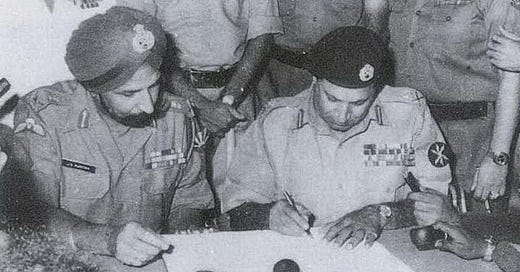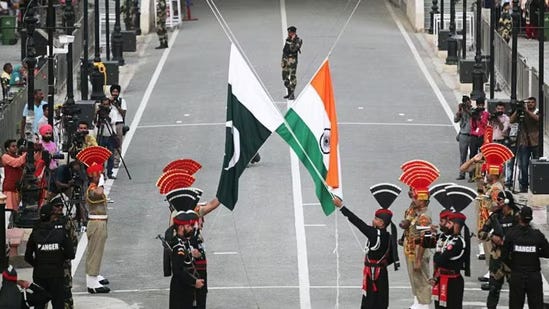Understanding the Escalation Ladder: Playbooks in the India-Pakistan Rivalry
Today's Paigham examines the concept of an escalation ladder, a strategic framework used to identify how conflicts intensify step by step.
Military tensions between India and Pakistan may have calmed, but both states remain engaged in diplomatic maneuvering to advance their respective narratives to the international community. Delegations from both sides are currently holding active diplomatic engagements abroad. While active conflict has subsided, there is still much to unpack from the military confrontation that unfolded last month. This edition of Paigham is dedicated to analyzing that conflict through the lens of escalation dynamics.
In today's issue, I broadly examine the concept of an escalation ladder, a strategic framework used to identify how conflicts intensify step by step. In the India-Pakistan context, conflict escalation has often followed a recognizable sequence of actions and reactions that could either culminate in full-scale war or in de-escalation. Originally articulated by Herman Kahn during the Cold War to describe nuclear conflict escalation, the concept can be applied to the India-Pakistan rivalry.
Kahn’s most detailed model comprises 44 rungs, each representing a specific action or intensity level, ranging from diplomatic gestures and economic sanctions to military actions, blockades, tactical nuclear use, and ultimately, all-out nuclear war. The model emphasizes that escalation is typically progressive rather than abrupt, allowing decision-makers to pause, assess, and decide whether to climb further or de-escalate. However, Kahn also acknowledged that escalation can be non-linear, with state actors potentially skipping rungs due to miscalculation, political pressure, or external influence.
Understanding the Escalation Ladder in the India-Pakistan Context
The Takshashila Institution proposed a framework after the 2016 Pathankot attack and Uri strike, outlining conflict escalation in three broad levels based on conventional thresholds:
Sub-conventional warfare: Often referred to as “jihad under the nuclear umbrella,” this level involves Pakistan’s alleged use of proxy groups like Lashkar-e-Taiba (LeT), Jaish-e-Mohammed (JeM), and Hizbul Mujahideen to launch attacks in Kashmir and the rest of India. India typically responds with counter-terror operations and heightened border security, including ceasefire violations. While below the threshold of conventional war, this creates persistent instability.
Single-sided conventional warfare: This stage includes limited, state-backed operations such as the 1999 Kargil War, where Pakistani soldiers and militants infiltrated Indian territory. India retaliated militarily but avoided opening other fronts, thereby limiting the scope of the conflict.
Two-sided conventional warfare: A full-scale military engagement between both countries, as seen in the 1965 and 1971 wars. The 1971 war resulted in Pakistan’s defeat and the creation of Bangladesh.
Operation Sindoor and Its Place on the Escalation Ladder
Unlike India’s previous military actions, such as the Uri (2016) and Balakot (2019) strikes, Operation Sindoor represents a marked intensification of India’s military posture. The operation targeted both terrorist infrastructure and military assets across Pakistan, employing unmanned aerial vehicles (UAVs) and aircraft.
India publicly released visuals of the strikes, and Pakistan confirmed the operation, marking a departure from prior denials. This mutual acknowledgment raised the stakes, pressuring the Pakistani military to respond and intensifying the conflict over four tense days.
Kahn’s Escalation Ladder Stages in the India-Pakistan Crisis
1. Ostensible Crisis & Diplomacy (Steps 1–4)
This phase included diplomatic expulsions, suspension of bilateral agreements, and heightened intelligence, surveillance, and reconnaissance (ISR) activities following the terrorist attack in Pahalgam. These were political signals preceding military actions.
2. Military Posturing & Readiness (Step 5)
Both countries conducted military drills, missile tests, and troop deployments along the International Border (IB) and the Line of Control (LoC), signaling preparedness without crossing into open conflict.
3. Limited Military Strikes (Steps 6–10)
India launched Operation Sindoor, deploying drone swarms and precision missile strikes on terror infrastructure inside Pakistan. It was the first Indian military strike across the IB since 1971, elevating the crisis to what Kahn calls ‘dramatic military confrontations.’
4. Reciprocal Military Response and Escalation Spiral (Steps 7–12)
Pakistan responded with Operation Bunyan-un-Marsoos, activating air defenses, scrambling fighter jets, and deploying electronic warfare systems. These were defensive escalations, intended to assert control without widening the conflict.
5. De-escalation & Ceasefire (Steps 13–16)
After four days of confrontation, backchannel communications and diplomatic interventions led to a ceasefire. While military readiness remained high, overt offensives came to a pause This phase reflects a stabilization moment that prevented further ascent on the escalation ladder, particularly into the realm of nuclear signaling.
In conclusion, these events bring to light the precariousness of India-Pakistan relations. With each rung climbed, the margin for error narrows, and the risk of miscalculation amplifies. In this case, diplomatic restraint remains prudent, if not essential.
Pakistan Paigham is dedicated to helping you gain a deeper understanding of Pakistan, where its complex and often intertwined relationship with India plays a significant role in that story. In upcoming editions, I’ll continue to explore Pakistan’s domestic dynamics in greater detail. I’d love to hear from you—what topics or questions would you like me to cover? Your input truly shapes this newsletter.
I’m thrilled to share and proud to help build the Network for Advanced Study of Pakistan (NASP) Fellowship — a rewarding opportunity for anyone passionate about becoming a leading voice in Pakistan studies.
If you’re a scholar or analyst curious about Pakistan's Local Politics & Political Systems; Military Influence and Civil-Military Relations; Economy; Technology, Education, and Social Media; Security; and Foreign Policy, this fellowship is designed for you.
The NASP Fellowship invites scholars and analysts to submit at least one research proposal on one or more of the pre-identified research questions related to Pakistan.
Visit the website for the list of research questions. To apply, submit the Indication of Interest form & await a response from us: http://shorturl.at/hE4yc Deadline to submit research proposal: 20th of June, 2025.
Open only to Indian nationals.






